
Text: Peter Johansson
Editing: Christer Lundstedt
Photos: Christer Lundstedt, Peter Johansson
Videos: Christer Lundstedt

Provinces: Dalsland, Bohuslän, Västergötland
Municipalities: Mellerud, Bengtsfors, Dals-Ed, Färgelanda, Uddevalla, Trollhättan, Vänersborg, Grästorp, Lidköping, Götene, Mariestad
Thursday 16th of July
08.32 It's morning for us here in Håverud and in our large room at Håverud's hostel. It's a little better weather today. It is good because we will go with a canal boat today and hope for beautiful views. The trip will take us from here in Håverud north up to Bengtsfors. The journey will take place on Dalsland canal.
09.27 With a hearty breakfast in the stomach and also good coffee, I am now ready for this excursion day. The same applies to Christer.
10.04 Sounds from emergency vehicles have been heard nearby. Did they drive on the road above us or what?
10.18 When we came out of the hostel, there was full activity at the house opposite. There were fire trucks, ambulance and personnel in equipment. A young Asian woman sat on the lawn, looked completely destroyed and despaired and a man in a fire-fighter's equipment asked about who had the key to room 3. We continued past all the drama to check in on the canal boat M/S Storholmen. Soon our journey on Dalsland canal will begin. We travel with the company Dalslands Kanaltrafik (https://www.dalslandskanaltrafik.se).
10.37 An online search has given us information that there has been a fire in the house/hotel next to the hostel but that the danger is over. There are plenty of people and not much space here on the boat. When Christer booked our tickets he was told that it was corona adapted with a limited number of passengers. If so, we wonder how many there are usually. Where do we sit when we eat our lunch? Most likely in our seats on deck, certainly not as I first thought, below deck.
10.52 The lines are untied, the engine is running. Now we are in the first lock of today. It's Lock 4 here in Håverud. The canal starts a bit from here at Lake Vänern. Our boat, M/S Storholmen has a long history. The boat was built in 1896 in Oskarshamn by Oskarshamn mechanical workshop. It was built for a Danish shipping company. After a few years the boat was sold back to Sweden and has been in traffic in Gävle under the name Bomhus II. During the First World War coal was scarce and the boat was therefore sold to baker Lundevall in Enköping. The boat then transported guests to the inn Fagerudd in Mälaren. This also became the new name of the boat. Ten years later it was sold to Holmsund and was then named Döbeln. The boat was then sold in 1933 to captain Edman in Ljungskile and received the current name Storholmen. It was put in traffic between Ropsten and Viggbyholm in the Stockholm archipelago. After a few years Storholmen came down to Gothenburg and went into traffic in the archipelago before it was sold in 1938 to Lennartsfors in Dalslands Canal, the traffic that it might have become best known for (source: Dalslands Kanaltrafik).
11.27 Here in the village of Håverud there is a system of four locks (No. 4-7) and an aqueduct that goes past and across the rapids of the Upperud River. The four locks give a level difference of 9,9 m. When you pass the lowest lock you follow a shorter canal stretch until it bends left. Next comes a double lock at the upper part of which runs a railway bridge; flap bridge with 8,5 m sail-free height. It takes its time to pass all this. There are also plenty of spectators covering everything that happens with our boat.
15.01 Our beautiful canal journey continues after passing another lock. This is truly a peaceful way of transportation. We calmly and still move towards the experiences.
18.35 Although the boat lunch was good we need some kind of food again. It is time to start the Golf (Today's third mode of transport) to find a restaurant. We can't be without a car trip for a whole day.
Friday 17th of July

Registration before the trip with canal boat M/S Storholmen.
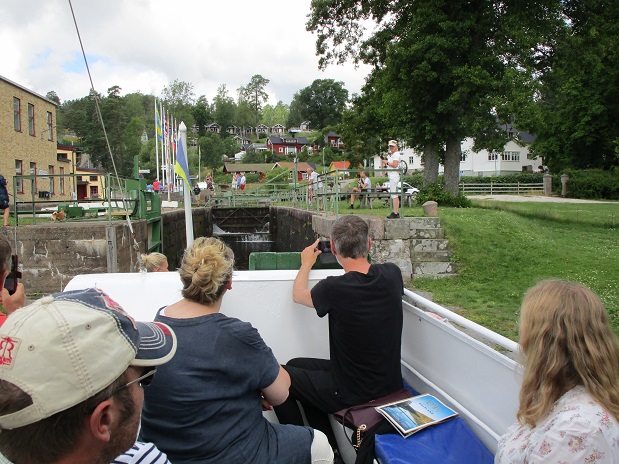
The boat trip starts in Håverud.

King Karl XV signed his name when Dalsland canal was built in 1868.

We are soon in the aqueduct.

We are slowly leaving Håverud.

Out on open water on the lake Åklång.

We are approaching the lock in Buterud.

We are meeting M/S Dalslandia in Dals Långed.
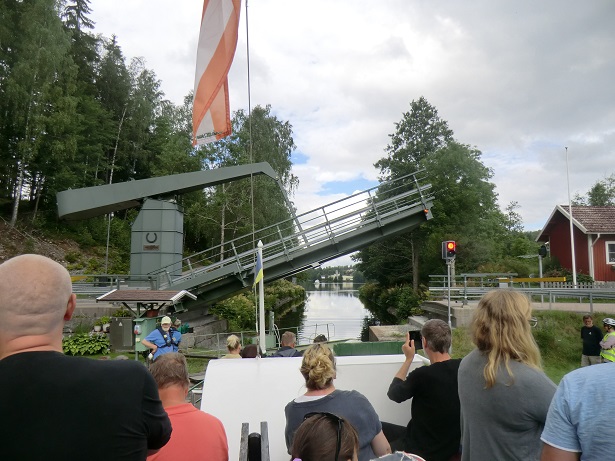
A bridge is opening in Mustadfors.
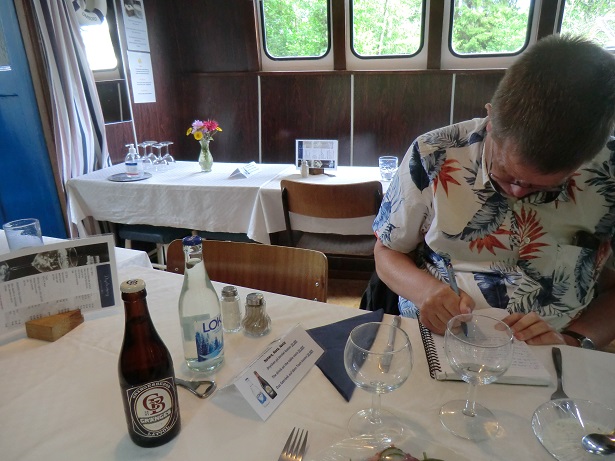
Peter in the restaurant on M/S Storholmen.

Christer´s lunch plate.

The water is being filled in a lock outside Billingsfors.

The most narrow part of the canal.

Beautiful views on the lake Bengtsbrohöljen.

We are leaving M/S Storholmen in Bengtsfors.

Bengtsfors station.

We are waiting for the local train from DVVJ.

Alternative transport at Bengtsfors station.

We are visiting Åsensbruk.
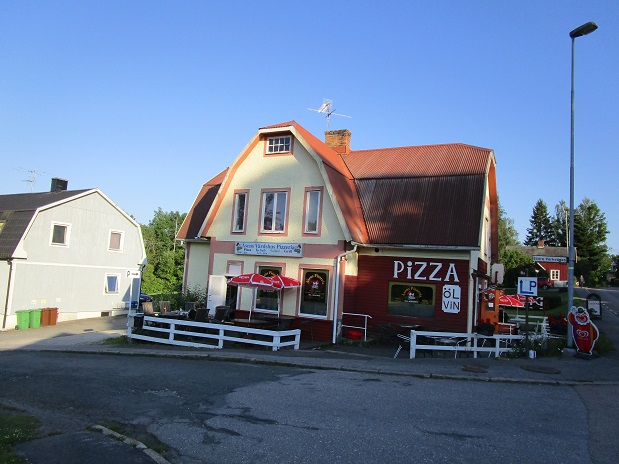
This one became this evening´s dinner restaurant.
07.45 The morning is here again. We have slept our second and last night at Håverud's hostel. I write the first lines of the second journal on this trip. Today it is twenty years since we went on the first big trip. Imagine how much we have seen and experienced since that day. Besides, imagine what a lot I've written in different journals over all those years.
09.21 I should probably be more attentive to what is being said to me. Otherwise, it will quite easy be some form of misunderstanding. We have checked out of the unmanned hostel and are again moving towards new places. We do not take the shortest route out of Dalsland. We will make a small trip west to see more of the area before travelling to the south. 09.35 It is not long distances that are flat or straight on the narrow crooked road between Håverud and Dals Långed. An uphill climb was so steep that all of a sudden we got stalled. Christer didn't have time to switch gear before we reached this "wall" in the middle of the countryside. The road is called Brudfjällsvägen. 09.44 After up and down and here, there and then here again we are now in Dals Långed. A beautiful and pleasant neighbourhood from what I can see. 10.12 After travelling on road 164 and passing the lakes Iväg and Grann we swung just before we reached Ed. The community and elk ranch here will have to wait until another time. Now we have turned in on road 166 towards the southeast. 10.45 In Bäckefors we changed our road again. Our journey on road 172 has taken us to another municipality in Dalsland, Färgelanda. Just now we were in Dals-Ed municipality. Now we have been to all the municipalities in the province. We hear a dove on our coffee break just before Tångelanda. On a bulletin board you can read some old notes and appropriations about auctions, Santa's path and Pokémon hunting.
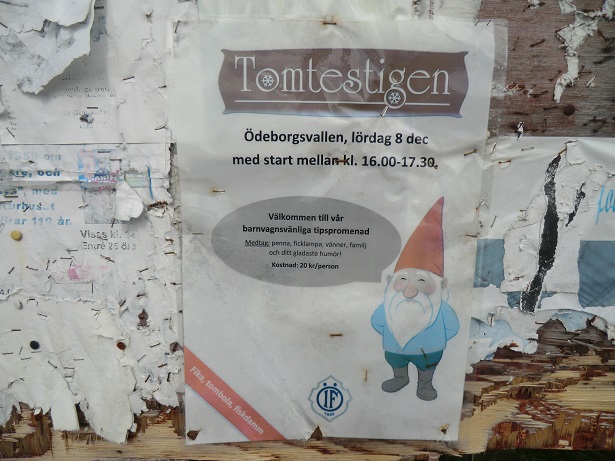
This information board is not exactly updated.

Golf players at Dagsholm Golfklubb.

Stone otters for the second time on this trip.

Kungsgatan, Uddevalla.
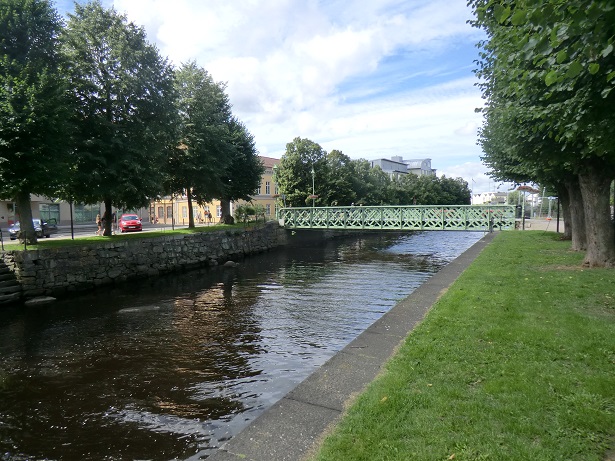
Bäveån is going through Uddevalla.

A wonderful start of the day in Uddevalla.

Kungstorget (King square) in the center of Uddevalla.
11.01 We have been pursued by a police car before and after we passed Färgelanda. Hopefully it's not us that they hunt. In any case, this leads to a little extra accuracy in terms of speed limits.
11.20 We have left road 172 at the village of Ellenö. Dagsholm Golf Club in Färgelanda is well attended. However, there will be no visit there by us. We continue our journey on another curvy road through our last municipality in Dalsland. 11.38 When driving on smaller roads, the signage is not always the best. We have entered the province Bohuslän and Uddevalla municipality without having received any information about this along the way. 11.52 We have parked our vehicle near the bus station at Kampenhof in central Uddevalla. Now it is important to remember what time we have to be back at the car to avoid parking tickets. 12.03 The time has come for a bench break this beautiful summer day. The sun is shining and a river is running past us. We are as I said in Uddevalla located in Bohuslän. We have not had time to visit Bohuslän earlier, at least not on this trip. Uddevalla, formerly part of Norway, has also been called Oddevold. It has a population of 36 121 inhabitants. 12.19 The river is called Bäveån and the park area we are in right now is called Hasselbacken. Its good weather but few others are in motion. 12.42 Before we left the park we had time to see a memorial stone regarding the peace at Brömsebro and an information board that some arrangement to attract, count and photograph fish had been mounted in the river. Get in on www.uddevalla.se/fiske to see this. Now we are at Kungstorget. Here is a statue of King Karl X and his adviser and fortress builder Erik Dahlberg. It's probably Sweden's first double statue. We recall that we encountered Mr Dahlberg in the past. Wasn't he the man behind the Tallinn Gate that we saw in Pärnu, Estonia in 2017? 13.30 We saw a little more of Uddevalla Center before we went to Jerusalem. It's a food truck, a rolling fast food kiosk at the bus station. Now we sit on a bench and eat our purchased kebab rolls. It will be a faster and easier lunch today. We have a lot to catch up with.

Uddevalla churchtower from 1751.

Peter by Bäveån in Hasselbacken.

Uddevalla municipality has a fishcounter.

King Karl X and Erik Dahlberg.

Stallbacka bridge is the entrance to Trollhättan.

Trollhättan Travel Center.

Time to explore Trollhättan.
13.42 After the quick simple meal we walked to Bohuslän museum and the harbour area down by the river. There was a lot under rebuilding at the moment.
13.55 On one last walk we passed a young lady who out in the sunshine talked in her mobile. To the one she was talking to, she said that she was sitting down indoors and that it was raining. Why did she say that? We won't find out. It's time to say goodbye to Uddevalla. 14.11 We have left Uddevalla and are on road 44. A cable middle rail separates the two, two-lane roads. Today we look around in the Trestad area. Trestad is a name for the nearby towns of Trollhättan, Uddevalla and Vänersborg. The three municipal central resorts together have about 110 000 inhabitants, which would mean that if Trestad was one and the same city it would be Sweden's eighth largest. 14.30 After we passed on the magnificent bridge Stallbackabron over the Göta River we have spun around a little on various streets and finally arrived at the commuter parking at Trollhättan Travel Center. We are for the second time today in a new province for the trip. Now we are in Västergötland. 14.44 We left the travel center behind us. When we crossed a pedestrian crossing, a woman came running from the right. She dropped something and we pointed it out. It was most likely something related to makeup that she picked up before she furthered further. Here in Trollhättan there are large decorated eggs here and there. The first we saw already inside the roundabout outside the travel centre. They are made by some local artists. 14.57 In Maria Albert's park we have seen something familiar. A miniature version of the petrol station from the TV series "Macken" is built here as a playground. Macken with the main characters Roy and Roger was a creation of Galenskaparna, a humour group from here Trollhättan. The series were shown on Swedish television in 1986. 15.14 Christer has established contact with an acquaintance of his from the student years in Umeå. We'll meet for coffee around 16.00. Now we sit down on a bench at what we assume is Trollhätte Canal. 15.43 We have walked along the beautiful canal, seen another painted egg and the revamped Drottningtorget. Trollhättan probably got its name from the fall area in the Göta River or possibly a small mountain found in Trollhättefallen. The city has had industries such as SAAB and also become a centre for film in Sweden. Trollhättan currently has 50,300 inhabitants.
Eggs and flags are welcoming us to Trollhättan.

"Macken" as a playground.

The railway bridge across Trollhätte canal.
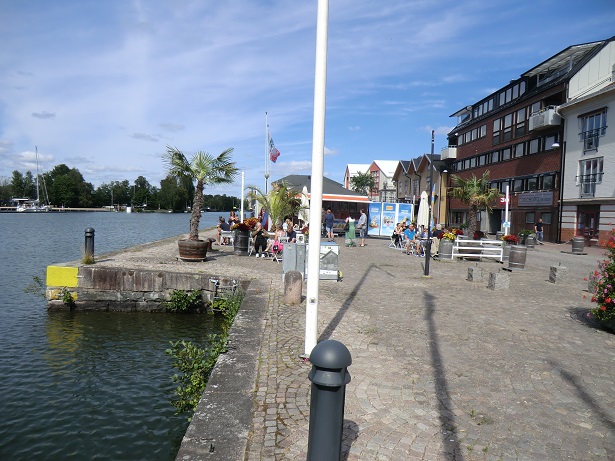
By the Trollhätte canal.

Karl Johans Torg and Villa Stranna.

Trollhättan has been considered a city 100 years.

Another painted egg with Trollhättan designs.
16.04 The two have now become three. The two of us have met Sofia, who is originally from Skövde but now lives here in Trollhättan. She and Christer lived in the same house during the student years at Umeå University. We're at another Espresso House. Where else to drink coffee this summer?
17.55 The time came, after having talked about with jobs, leisure, travel and a little of each, to walk separate ways. It's nice to combine a round trip in Sweden with seeing old friends again. Now Christer and I will finish the day trip and bring us towards the hotel that will give us a room and two beds. 18.04 We got several great tips from Sofia regarding more attractions in Trollhättan. At first we thought to try to catch up with these but soon realized that it would only mean stress and lack of time. We have a check-in time, a dinner that needs to be eaten and a city to see before it gets dark tonight. 18.20 Barely had we left Trollhättan as we reached Vänersborg. It is not far between the cities here. Now we are on a pay/parking disc area near our hotel, Strand hotell (http://www.strandhotell.com). Christer is away and checks if there is a hotel parking we can use. 18.43 There is no specific hotel parking. Upon check-in we received a temporary parking disc or more precisely a parking note. It should be filled in and put in the front window of our car. A happy and charming woman checked us in and gave us information about the hotel, the city, the surroundings and the city's great son, Birger Sjöberg. 19.42 Dinner must be eaten and fortunately we had saved time by reading in advance about the restaurant offer here in Vänersborg. Now we are at B. B. Q Kolgrill & Pizza (http://bbqkolgrillpizza.se). There will be no pizza tonight. Instead, both of us will have a mixed Grill. It is always delicious food when visiting a charcoal grill.
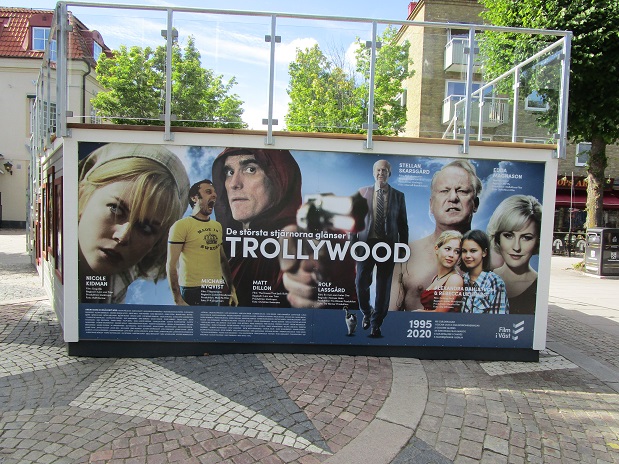
Trollhättan is a film town. Here they refer to it as Trollywood.

Sofia and Christer at Espresso House, Trollhättan.

Strand Hotell, Vänersborg.

Dinner at B.B.Q Kolgrill & Pizza.

Christer is walking into Vänersborg.

Evening sun on Vänersborg church.

The birds like this spot.
20.23 After a very tasty meal our Friday evening here in Vänersborg continues. Before the sun sets, we will try to make time to see and document as much as we have time to do. Vänersborg is by Vänern. You can hear the name. It has 24,095 inhabitants. Before the county merge in 1998, the city was the county seat of Älvsborg County and is now the seat of the political leadership in Västra Götaland. The great son of the city, the author, composer and troubadour Birger Sjöberg, is the author of Vänersborg's popular nickname, Little Paris.
20.34 Now we can check off something on our bucket list. We sit on a yellow metal bench in front of the church in Vänersborg. At least I haven't done this before. It's a lovely summer evening and the cars with young people are competing with the mopeds for the space on the city streets. 20.52 We are having a new yellow bench stop. We are now in the Skräckleparken overlooking Lake Vänern. Somewhere near where we are some of the people of Vänersborg used to light fires in the old days. This was to attract ships so that they could plunder these. 21.36 It is beautiful by Lake Vänern. Some have chosen to have a nice evening outing down by the water. We have just reached the Frida statue that is connected to Birger Sjöberg. There is a lot here in Vänersborg that is connected to him in different ways. Birger Sjöberg is known for the poem collection Frida's bok, the novel Kvartetten som sprängdes and the poem Kriser och kransar. Who was Frida? Well, her name wasn't Frida. The one he was referring to was a youth love named Karin. 21.58 We are at home at Strand Hotell again. Since last we have bought a little of each at Hemköp supermarket. Now we have to find a good option for tomorrow's lunch. We do not want more junkfood like pizza, kebabs and hamburgers. 23.15 The evening in Vänersborg ends with the movie Jägarna (The Hunters) on TV4. We'll see if we can see the whole thing. We've seen it before, but we don't remember all the details.

Some women are having an evening excursion by the lake.

The Frida sculpture to the memory of Birger Sjöberg.

Frida is looking out over lake Vänern.

Another truth about coffee.
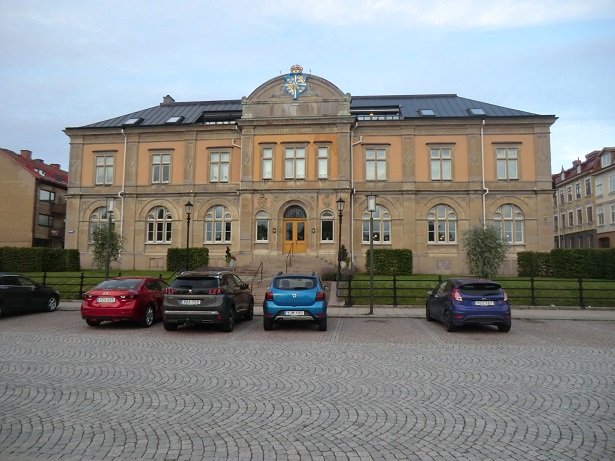
Riksbankshuset (National bank house), Vänersborg.
Saturday 18th of July
08.44 It is overcast over Vänersborg. We've had a great night here at Strand Hotell. Soon it's time for breakfast and then there will be more travelling here in Västergötland.
09.32 The breakfast here at the hotel was of the simpler kind. We got sandwich wrapped in plastic, small juice tetras, small yogurt and coffee. Everything is adapted to/against (or how it now is) the Corona virus. To, as I did, sit and cough in the breakfast dining room is not that smart in these times. 10.10 We feel ready with Vänersborg. Google Maps is again activated. We begin our journey towards a castle. Will Ruth be able to find it, can we find it? 10.16 We started the weekend with driving the wrong way. It is easy to get wrong when listening to a voice on the phone that is not synchronized with the junctions. Had we ignored it and just looked at the signs, everything would be much easier. At least we're rolling through Vänersborg in the right direction. 10.32 The surroundings are green. We have passed Vargön. A sign we just passed said, Hunneberg 3. Someone else will tell you how it is in Hunneberg. Hunneberg is one of two mountains east of Vargön. Halleberg is the second. They are table mountains/hills and not very high, but when the surroundings are completely flat, the mountains are clearly visible. 10.38 In the roundabout Smärgels kurva we have turned in on road 44/47. The curve is named after a petrol station that used to be there. We are now in Grästorp municipality. 10.50 Road 47 goes to Falköping. We're not going there today. We roll eastwards on road 44 instead. 11.02 Now it will be eleven o´clock coffee. We are at a combined parking place and bus stop for Västtrafik. We're standing right before the entrance to Tranum. 11.31 We have three beige coloured horses to the right of us. We've swung off the 44 and taken the scary narrow road to Tranum. There are varying widths on this year's travel routes. It remains only to hope that we do not have to meet anyone because we are surrounded by trees and stone walls. We'll take a shortcut towards today's first stop.

Läckö slott by lake Vänern.

Christer at the water outside Läckö castle.

We are entering the castle.

The inner courtyard at Läckö castle.

Heraldry symbols and sculpture at Läckö castle.

We are leaving the beautiful area around Läckö castle.
12.04 Now the road is a bit wider and above all busier. There are bicycles, motorcycles, cars and motor homes on the move. Is everyone, like us, going to the castle?
12.14 Christer found an excellent parking place just near Läckö Castle. There were not many vacancies left so now we had some luck. We had no idea it would be so popular to come here. Soon there will be a large dose of culture and history in this beautiful place. 12.36 On a cape in and above Lake Vänern lies the ancient Läckö Castle. Once upon a time it was home to Magnus Gabriel de la Gardie. It is a mighty castle in need of renovation. The outer walls look worn out. It is located on Kållandsö and was founded in 1298 by Brynolf Algotsson. The castle belonged to the bishops of Skara in the Middle Ages and was left in 1615 as a county for the family De la Gardie, but was inducted to the crown in 1681. Läckö has later been granted to Carl Gustaf Tessin in 1752 and 1810 to Carl Johan Adlercreutz and has later been leased, including within the Rudenschöld family. The castle and King's house are now owned by the State (Source: Wikipedia) 12.43 We have photographed the castle and Lake Vänern from various positions and angles. Now let's see if we can get into the castle too. 12.58 Now its bench break for me on the castle's inner courtyard. Christer for his part documents in the form of film and photo. The inside of the castle is more beautiful than the outside. Here people queue to get even further into the castle. Because of the corona pandemic, as usual, there are limitations so it takes time if you want to wait for your turn. Christer has a personal connection to this castle. In the 1990s when we were history students in Umeå, we started with genealogy. On his paternal grandmother's side Christer found connections to a noble military family who was stationed in Jämtland. It was called Planting-Bergloo. Based on it, he has found many ancestors in the Swedish nobility. One of these, Måns Börjesson managed this castle with county for count Jakob de La Gardie in the early 1600s. Måns son Börje was then ennobled with the name Skeckta. 13.27 Anyway, we cannot see more here now, at least not of Läckö Castle and surroundings. It's time to pull on towards lunch and city environments. 14.07 We have parked in another city, Lidköping. We sit on another bench, a green one. Another hunt for lunch has begun. As usual we try to find something other than pizzerias but easy it is not if you want to eat quickly and efficiently. Lidköping usually calls itself Lidköping at Vänern to avoid being mixed up with Linköping. The city is famous for its bandy team Villa Lidköping and its porcelain manufacturing, Rörstrand. It has 23,467 inhabitants.

We are taking a rest outside Lidköpings Folkets Hus.

Stenportsgatan, Lidköping.

The old water tower in Lidköping.

Peter is waiting for his lunch at Pizzeria Amigo.

Stadsträdgården, Lidköping.

Lidan is the small river going through Lidköping and ending in lake Vänern.
14.41 So it was time again. Despite promises and holy oaths to the contrary I have ordered a pizza at Pizzeria Amigo (http://pizzeriaamigo.se) on Lottkällsgatan 1. We needed food and the clock has flown by so fast. There was simply no time to eat something more spectacular. There are a bunch of pizza eating youngsters and outside the pizzeria there is the supermarket ICA Nära Klockan.
15.32 It went well to eat again, even if it was pizza. Now we take a bench break down by the river Lidan and think about how small the world is anyway. Just now we have seen one of the staff at the pizzeria stroll along the river and also the young people who sat there just cycled past us. 15.48 The scent of donuts reaches us here on the Nya Stadens Torg (New City Square). A child shouts at his mother. There is also the city's Old Town Hall, which once stood out at Läckö Castle. There is also the so-called Count House. King Karl XII's corpse laid there on the road between the place of death in Halden and Stockholm. 16.08 Now we and our Google Maps voice Ruth do not fully agree on how to get to the next stop. 16.16 Unity prevails again. We just left the roundabout and once again ended up on road 44. 16.43 Google Maps/Ruth's accuracy took us a turn out into the countryside before we swung back on the E20 instead of driving there directly. The disadvantage of following the advice from Google Maps is that we are sometimes sent to the geographically closest route instead of the smoothest route. 17.24 There is no order with the navigation today. At least we're in Mariestad. We found a parking lot down by the harbour and are now at the city cathedral. Like Kalmar Cathedral, Mariestad's cathedral has the designation cathedral without being one. From 1580 to 1646, Mariestad was the seat of a superintendent – an ecclesiastical office in the period immediately after the Reformation, which included northern Västergötland and Värmland. The superintendent was the head of the diocese without being a bishop. In 1646 the Mariestad diocese was laid down and the superintendent was moved to Karlstad, whereupon the Diocese of Karlstad was formed. A royal letter on January 9, 1696 stated that the Church in Mariestad is no longer to be regarded as a cathedral (source: Wikipedia). The church tower with its 82 meters is divided fifth place for high church towers in Sweden.

The town hall in Lidköping has a history being the hunting lodge of Magnus Gabriel De La Gardie.

Beautiful flowers on Nya stadens torg, Lidköping.

The Rörstrand factory in Lidköping has a long history of making porcelain products.

Mariestad cathedral is not a cathedral anymore.

Västerlånggatan, Mariestad.
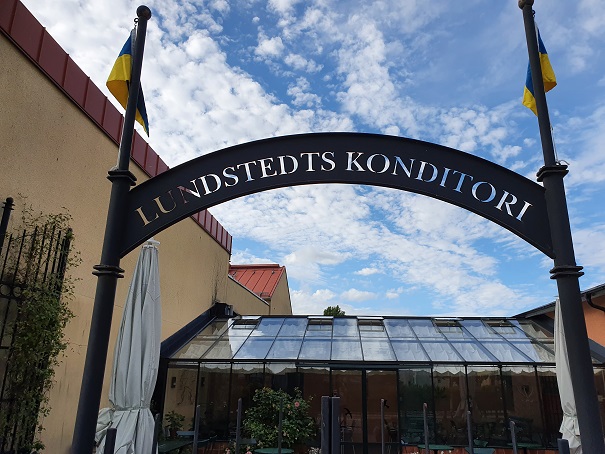
Christer found a café/bakery shop with his surname.
17.59 We walk through the older parts of the city. There is something special about older preserved city parts. It is cobbled streets and a completely different atmosphere than in more modern neighbourhoods. In the old days there was more charm in the houses. Mariestad was founded in 1583 and got its name from Maria of Pfalz who was married to King Karl IX. Today, 16,611 inhabitants live here.
18.10 We have been down by Lake Vänern for a while but will now walk towards a suitable supermarket. 18.23 Christer has entered ICA Kvantum Oxen to purchase what we need in the future. It concerns the upcoming dinner and breakfast. I of ordinary size and the backpacks of smaller size are waiting outside on a bench. They are not welcome inside. It is certainly not any major problems but still. In the vicinity of ICA Christer has found a café/pastry shop with his surname, Lundstedts konditori (https://www.lundstedtskonditori.se). It has been operating since 1911. 18.40 Now things are purchased. Heading towards the centre we have passed a cool fountain on the Nya Torget and are heading into a small park. 18.55 It has become time to switch from urban environment to rural. We are back at the car at the guest harbour parking place. Here nearby there are plenty of restaurants and a lot of people in motion. At least this corona virus and distance thing doesn't show tonight right here. 19.09 We turned from E20/road 26 and into only road 26. Just now the Inlandsvägen started. We're back on it. I guess this is where it just starts. 19.45 We finally arrived at Jugesh Vandrarhem & Rum in the village Sjötorp located at the outlet of the Göta Canal in Vänern. Our host of Indian origin came out of a grocery store and we went there to check in. It was claimed that we did not cancel breakfast as well as rent of towels and bed linen. It did not match and the sum was corrected. Now we live in Room 9. There is no hob, even though it is promised. However, we have hopes of solving this with dinner in some way.

A fountain with the sculpture Vänerskutan on Nya torget (New square), Mariestad.

Mariestads Stadshotell (Mariestad City Hotel).

Peter in central Mariestad.

Jugesh Hostel & Room, Sjötorp.

Our spacious room.

Red light at Göta canal.
20.16 We have tried to find solutions to how tonight's dinner should be prepared. We have bought pasta but have no way to boil it. We also have sausages but they can be heated in the microwave in the room.
20.34 Our kettle has brought us hot water. The hot water has been poured into a new unused plastic trash can and in the water we have put the evening pasta. In the absence of pans, it is allowed to improvise simply. Now we let the pasta soak there while we take an evening walk around the village. Here in small Sjötorp there is a population of only 429 people but now in the summer it is full of people here. Most come because of the Göta Canal. Some come with their own boat too. 20.45 Now we are at the place where in 1810 the first shovels, of many, were taken on the mastodon construction Göta Canal. It is a canal that stretches through Sweden in a west-east direction. We have even seen, a for me, new petrol station Green Petroleum. It is now time to see even more of the surroundings. 20.57 At Café Baltzar von Platen there is live music right now. We listen from a distance and enjoy the view of the canal and the beautiful summer evening. 21.44 It was beautiful down by Lake Vänern where we admired the sunset. Now the pasta the that bathed in a trash can and even the sausages are heated. Soon it will be dinner after all. 22.40 It was simple but it was delicious. Really fleshy sausages it was, 95% meat content. 23.56 Today is almost over and what happens tomorrow is roughly planned. We round off with a beer from Mariestad each. Everything else had actually been wrong in these areas.

Göta canal starts (or ends) in Sjötorp.
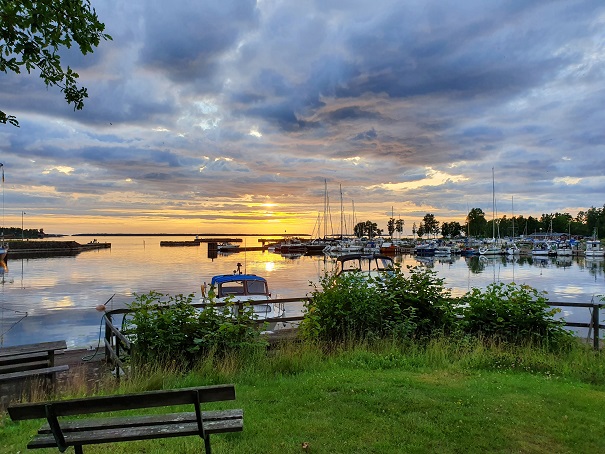
A beautiful sunset in Sjötorp.
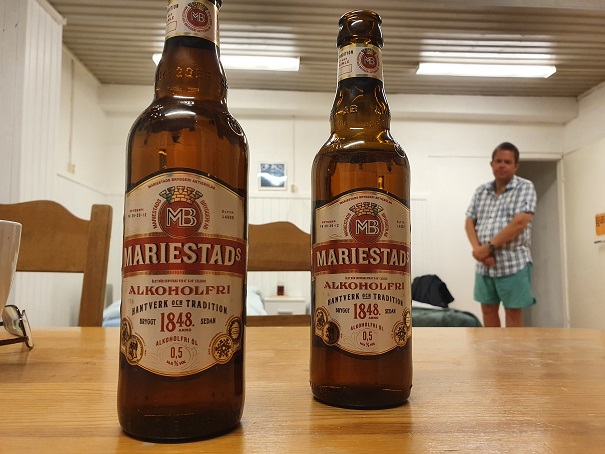
Peter is waiting for this evening´s Mariestad beers.
You can see 55 photos from July 16 in this photoalbum.
You can see 75 photos from July 17 in this photoalbum.
You can see 93 photos from July 18 in this photoalbum.